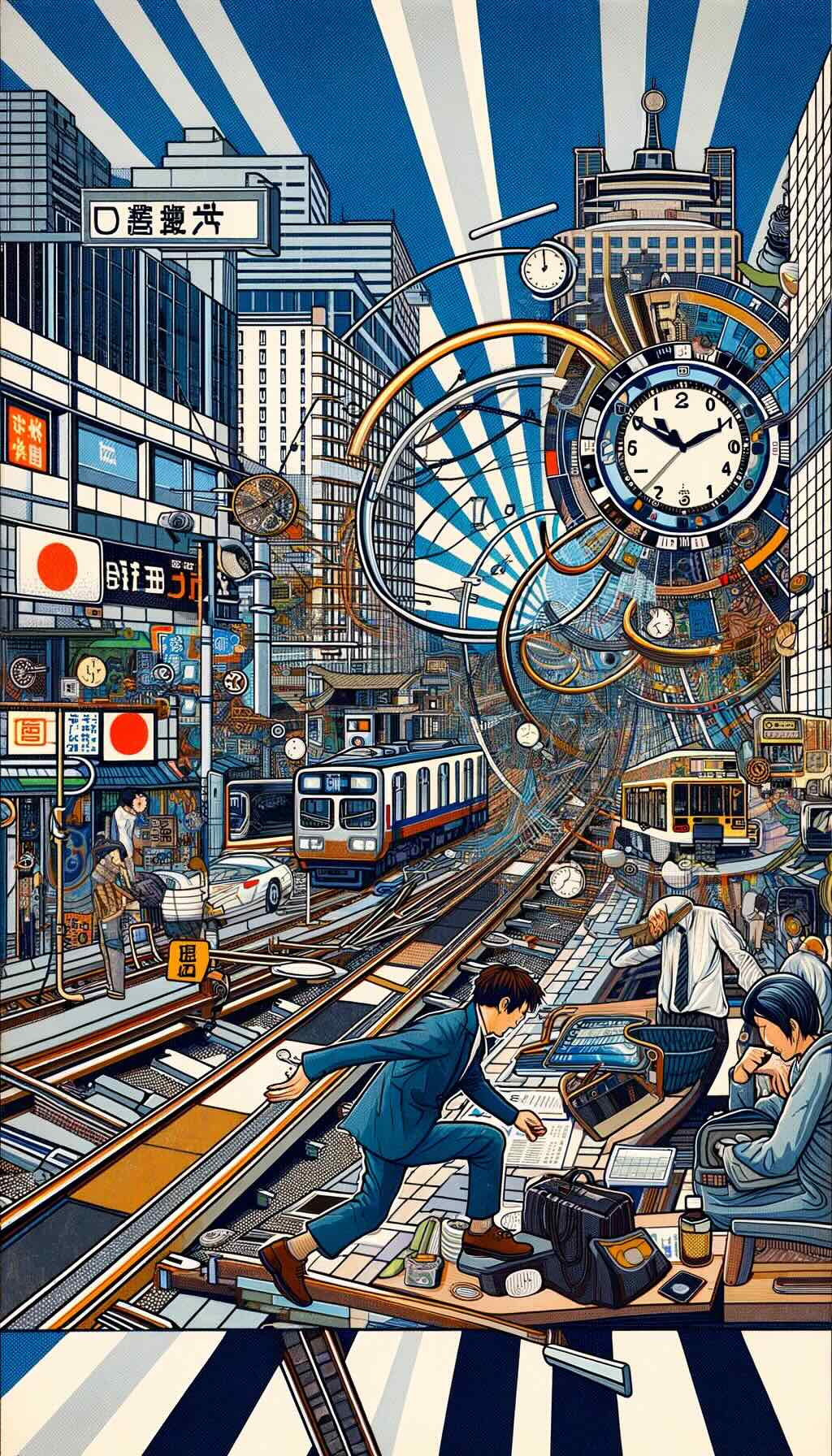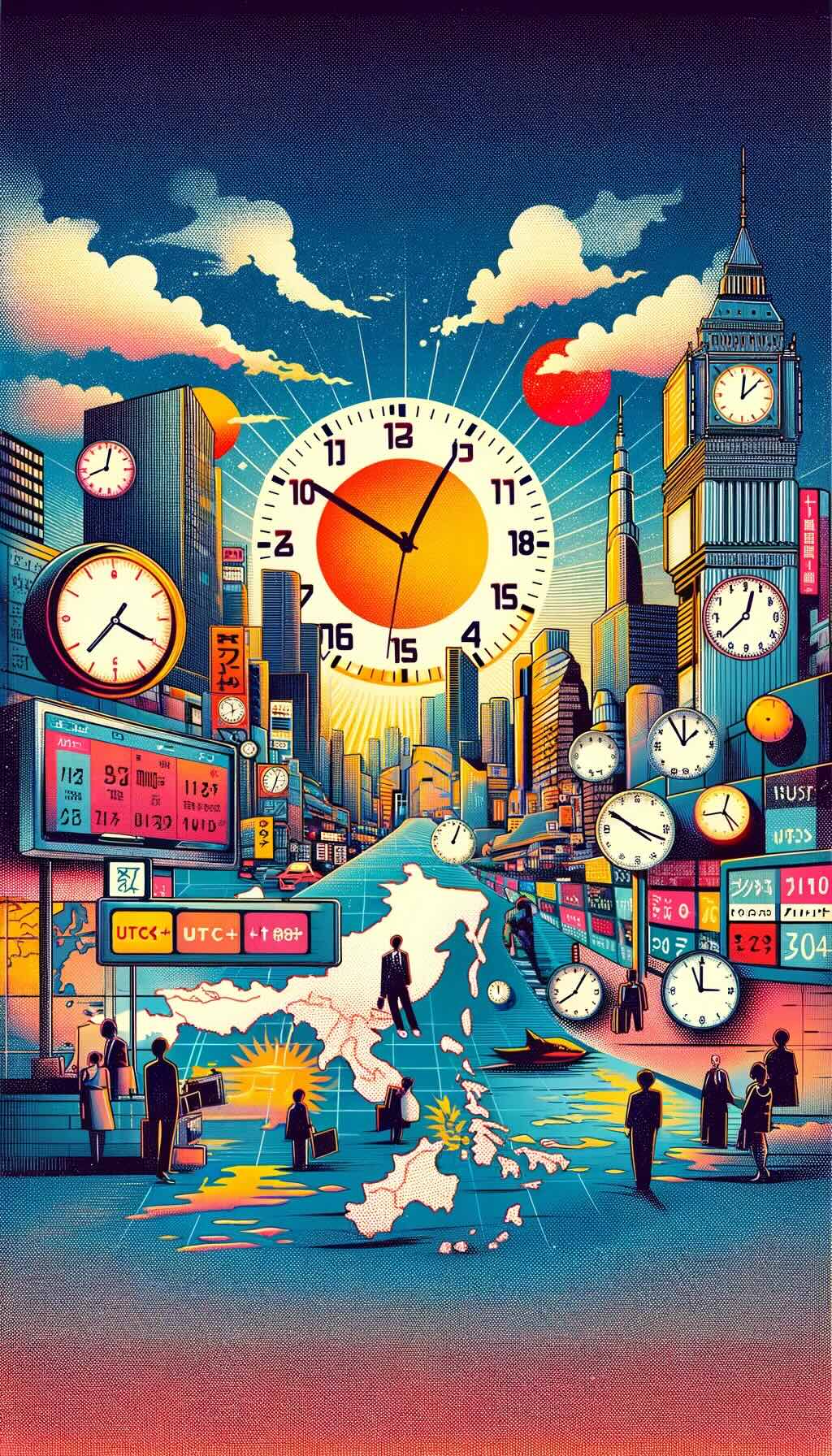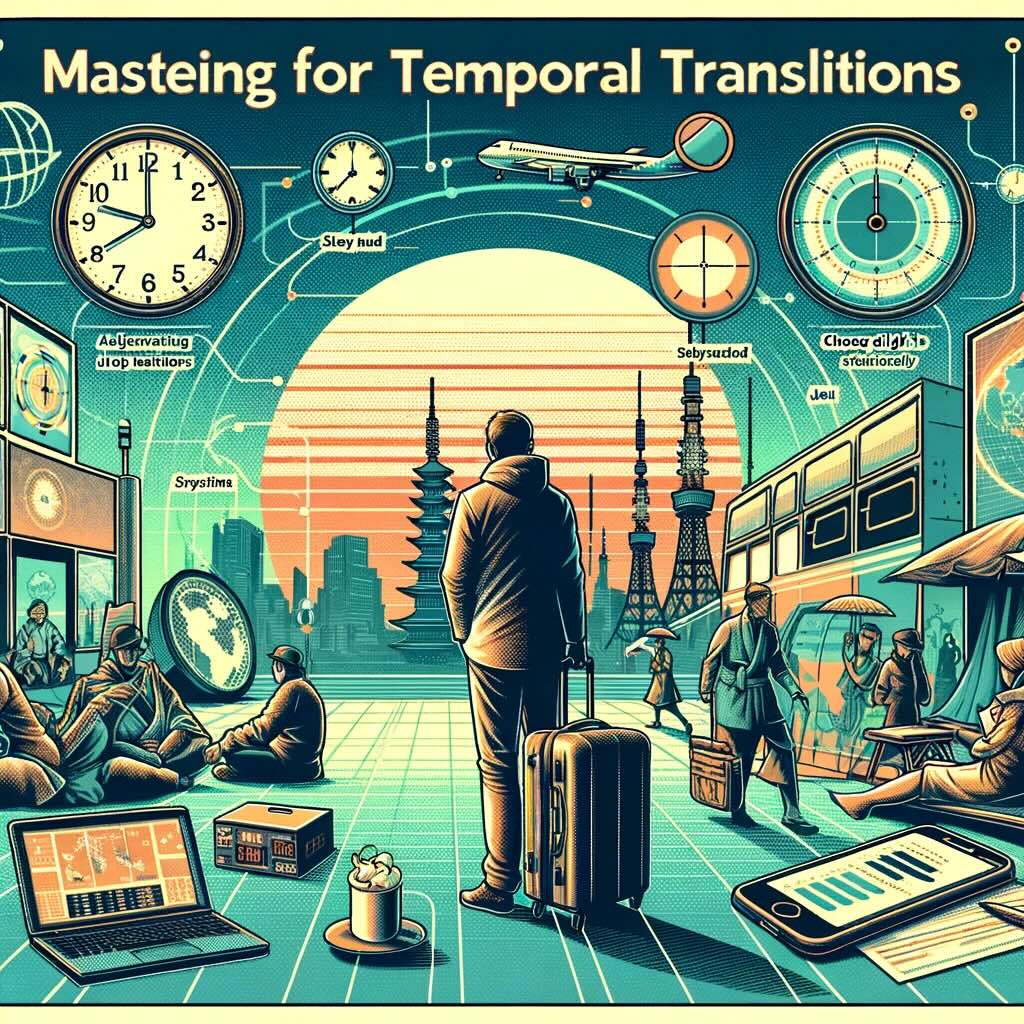As globe-trotters and jet-setters, we often find ourselves entangled in the intricate web of world time zones. Among these, the Japan Standard Time (JST) stands as a beacon in the East, an essential cog in the wheel of global timekeeping. This article delves into the essence of JST and its pivotal role for travelers, offering a comprehensive understanding that goes beyond mere clock-watching.

The concept of time zones, a brainchild of Sir Sandford Fleming in the late 19th century, revolutionized how we perceive time in different parts of the world. It’s a fascinating system that slices our planet into 24 longitudinal sections, each representing a distinct hour of the day. Navigating through these time zones is a rite of passage for the modern traveler, a journey that requires both patience and planning.

For those embarking on a voyage to the Land of the Rising Sun, a grasp of Japan Standard Time is more than just a convenience – it’s a necessity. Japan, steadfast in its observance of JST throughout the year, does not dabble in the daylight saving time shuffle. This unwavering commitment to a singular time zone simplifies life for locals and visitors alike, providing a constant temporal anchor in the ever-shifting tides of international travel.

The Cultural Significance of JST in Travel
Understanding time zones, especially JST, is not just about adjusting your watch upon landing at Narita or Haneda Airport. It’s about syncing with the rhythm of a nation, tuning into the tempo of Tokyo’s bustling streets, and aligning with the serene pace of Kyoto’s temples. It’s about respecting and adapting to the cultural heartbeat of a place where time is valued and punctuality is not just appreciated but expected.
source: Λsk Λbout Guide on YouTube
In this era of global connectedness, being savvy about time zones like JST isn’t just a travel hack; it’s a form of cultural literacy. It’s about building bridges across time and space, understanding that while we may live in different hours, we share the same moments. Whether it’s scheduling a video call back home without waking up your family in the dead of night or planning a seamless itinerary that maximizes your daylight hours in Japan, a firm grasp of JST empowers you to navigate these challenges with ease.

Embracing the Journey Through Japan Standard Time
As we unpack the intricacies of Japan Standard Time in the sections that follow, let’s embark on a temporal journey. A journey that not only enlightens us about the ticking hands of the clock but also invites us to explore the rich tapestry of Japanese life that unfolds within each hour, each minute, each second under the steady gaze of JST. So, fasten your seatbelts, set your watches, and let’s dive into the timely world of Japan Standard Time.

Understanding Time Zones
At the heart of our global tapestry lies the enigmatic concept of time zones, a marvel of human ingenuity that segments the world into a mosaic of temporal slices. Each time zone, a longitudinal wedge of the Earth, is fundamentally a 24-part division, a testament to our planet’s daily rotation. This segmentation ensures that noon is roughly when the sun is at its zenith in each zone, bringing a semblance of temporal order to our world’s diverse geography.
source: Only In Japan * Go on YouTube
Our globe’s timekeeping is akin to a finely tuned symphony, with each time zone playing its distinct part in the harmony of daily life. This system, a product of both geographical necessity and international accord, has profound implications for travelers. As you jet across continents and oceans, you’re not just traversing physical distances; you’re leaping across these invisible temporal boundaries. This leap is more than a mere resetting of watches; it’s an adjustment of your body’s internal clock to the rhythm of a new land. It’s the transition from the familiar cadence of home to the unfamiliar tempo of a foreign time zone.

Navigating the Turbulence of Jet Lag and Time Zone Transitions
Jet lag, the bane of long-haul travelers, is a direct consequence of these rapid time zone transitions. Our bodies, governed by circadian rhythms, are finely tuned to the 24-hour day. When we whisk ourselves across time zones, we disrupt this internal rhythm, leading to the dissonance of jet lag. Symptoms like fatigue, insomnia, and disorientation are the body’s protest against this temporal upheaval.
But fear not, intrepid traveler, for understanding this phenomenon is the first step in conquering it. Knowledge of time zones enables you to plan strategically, aligning your travel schedule with your body’s natural clock. Savvy travelers often begin adjusting their sleep patterns a few days before departure, gradually syncing with the destination’s time. It’s like tuning an instrument before a concert, ensuring a harmonious performance.
Moreover, time zone awareness aids in crafting a travel itinerary that’s in tune with your destination’s day-night cycle. Imagine planning a visit to Japan’s bustling Tsukiji fish market, only to find it’s closed because you forgot to account for the time difference. Or scheduling a conference call back home, and realizing it’s the middle of the night there. These temporal missteps, while often minor, can cascade into a symphony of travel hiccups.

Japan Standard Time (JST) Detailed
The Geographical Canvas of JST
Japan Standard Time (JST) paints its temporal strokes over a fascinating geographical canvas. Encompassing the entirety of Japan, from the northernmost tip of Hokkaido to the southern subtleties of Okinawa, JST is the unifying temporal heartbeat of this archipelago. This singular time zone blankets a land where ancient traditions meld seamlessly with futuristic innovations, a place where the sun’s first rays bless the nation, earning it the poetic moniker, “Land of the Rising Sun.”
The Distinct Characteristics of JST
- UTC Offset – The Backbone of JST Delving into the mechanics of JST, its cornerstone lies in the UTC offset. Standing at UTC+9, JST is nine hours ahead of the Coordinated Universal Time, the world’s time standard. This offset is the fulcrum around which the Japanese temporal world pivots, placing it ahead of many other global time zones. For the traveler, this means experiencing the day while others are wrapped in the night’s embrace, a unique temporal vantage point that adds an exotic twist to your journey.
- Absence of Daylight Saving Time – A Steady Temporal Anchor A noteworthy feature of JST is its steadfast rejection of daylight saving time. Unlike many parts of the world where clocks are shuffled back and forth, Japan’s timekeeping remains as constant as the North Star. This absence of temporal shifting offers travelers the luxury of consistency. There’s a certain tranquility in knowing that the time you set on your watch upon arrival will remain unchanged throughout your sojourn in Japan.
JST in the Global Timekeeping Tapestry
The position of JST on the global stage is akin to a lighthouse in the sea of international time zones. Its alignment with major time zones is a dance of synchrony and contrast. To the west, it stands an hour ahead of China and Korea, a subtle yet significant lead. To the east, it shares daylight hours with the early afternoons of European cities like Paris and London, while the Americas are still cloaked in the veil of night or the early whispers of dawn.
For the traveler, this alignment is a puzzle of connections. Imagine you’re in Tokyo, basking in the neon glow of Shibuya Crossing at 9 PM; it’s lunchtime in London and early morning in New York. This time difference is not merely a numerical shift but a window into parallel worlds. It is the realization that as you roam the streets of Kyoto or savor sushi in Tokyo, different parts of the world are in a different temporal chapter.
Embracing JST in your travels is more than adjusting to a new time zone; it’s tuning into a rhythm that has governed the lives of the Japanese for centuries. It’s about synchronizing with a pace of life that balances the serene flow of traditional tea ceremonies with the pulsating energy of Tokyo’s tech-driven heart. In Japan, time is not just measured in hours and minutes; it’s experienced through moments and memories.

Historical Context of Timekeeping in Japan
Evolution of Timekeeping in Japan
The story of timekeeping in Japan is a fascinating journey through history, mirroring the nation’s evolution. Long before the advent of modern clocks, Japan, like many ancient civilizations, relied on the natural world to measure time. Sundials and water clocks, known as “Rokoku,” played a pivotal role in the temporal life of early Japanese society. However, these methods were closely tied to the natural rhythms of the seasons and daylight, making them inherently variable.
As Japan opened its doors to the West during the Meiji Restoration in the late 19th century, it also welcomed Western concepts of time. The traditional Japanese time system, which divided daylight into six equal periods regardless of the season, gradually gave way to the more standardized and consistent system imported from the West. This transition was not just a technical shift in timekeeping methods; it represented a deeper transformation in the Japanese worldview, aligning the nation more closely with the international community.
Shift to Standard Time and Its Significance
The shift to standard time in Japan was a landmark event, signifying Japan’s integration into the global fabric. The adoption of standard time was part of a broader movement of modernization and Westernization during the Meiji era. This move was crucial for Japan’s burgeoning industry and commerce, enabling synchronization with international markets and establishing more efficient communication and transportation networks.
This shift also had significant cultural implications. It marked a departure from the traditional, nature-based understanding of time, moving towards a more abstract, uniform concept. This change reflected a broader transformation in Japanese society, as it rapidly industrialized and embraced technological advancements.
Establishment of Japan Standard Time
Japan Standard Time was officially established on January 1, 1888. This move aligned Japan with the global movement towards standardizing time, which was gaining momentum following the International Meridian Conference in 1884. By adopting a time zone of UTC+9, Japan not only facilitated better communication and coordination with Western nations but also asserted its position as a modern, internationally engaged country.
The establishment of JST was more than just an administrative decision; it was a symbol of Japan’s commitment to being a part of the global community. It reflected a desire to participate in international affairs on equal footing and marked a significant step in Japan’s journey from a feudal society to a modern state.

Practical Implications of JST for Travelers
Navigating Itineraries in the Realm of JST
Embarking on a journey to Japan, where JST reigns supreme, demands a strategic approach to itinerary planning. Enveloped by this singular time zone, every experience in Japan – from the serene dawn at a Zen temple to the neon-lit nightscapes of Tokyo – unfolds in sync with JST. For the savvy traveler, this means immersing oneself in the rhythm of Japan’s hours and minutes.
Crafting an itinerary under the auspices of JST calls for a delicate balance. It’s about harmonizing your biological clock with Japan’s temporal cadence. Jet lag can be a crafty adversary, but with foresight, you can outmaneuver it. Gradually adjusting your sleep schedule prior to departure can smooth the transition, ensuring that your first sunrise in Japan greets an alert and eager spirit.
The absence of daylight saving time in Japan is a boon for travel planning. This steadfast consistency in timekeeping means one less variable to juggle as you plot your journey across temples in Kyoto, markets in Osaka, or the untamed wilderness of Hokkaido. The uniformity of JST across the archipelago ensures that whether you’re watching the snow monkeys in Nagano or enjoying the subtropical climate of Okinawa, the temporal language remains the same.
JST and the Ballet of Flight Schedules
The world of air travel bows gracefully to the dictates of JST. For international travelers, this often means arriving in Japan in the early morning, a common scheduling practice that aligns with the operational hours governed by JST. Understanding the nuances of these schedules is crucial. Early arrivals can offer a full day of exploration but consider the early check-in times at hotels or the possibility of fatigue after a long-haul flight.
Navigating Japan’s airports, be it Narita, Haneda, or Kansai, becomes a smoother experience when you’re attuned to JST. Flight departures and arrivals, airport shuttles, and connecting domestic flights adhere strictly to this time zone. A keen awareness of JST not only helps in catching flights on time but also in synchronizing with Japan’s commendable punctuality in public transportation.
Staying Connected Across Time Zones
In our hyper-connected world, staying in touch with family, friends, or colleagues back home is paramount. Here, JST plays a crucial role. The time difference can be a tricky chasm to bridge, especially when coordinating across continents. It’s a dance of timing, where one must skillfully align the JST clock with the time zones of those back home.
The key lies in planning and awareness. Tools like world clock apps become invaluable, helping you visualize the time difference at a glance. Scheduling calls or video chats requires a bit of temporal gymnastics, balancing the JST schedule with the waking hours of your home country. It’s about finding that sweet spot where time zones overlap in mutual convenience.

Navigating JST During Your Visit
Synchronizing with Local Time Upon Arrival
Stepping off the plane and into the vibrant tapestry of Japan, the immediate challenge for any traveler is aligning with Japan Standard Time (JST). This adjustment is more than just setting your watch forward; it’s about recalibrating your internal clock to Japan’s tempo. Combatting jet lag is an art – one that begins with well-planned sleep strategies during your flight and continues with immersion in local routines upon landing. Engaging in light activities and soaking in daylight helps reset your circadian rhythms, attuning you swiftly to the local time. The key is to gently coax your body into the rhythm of JST, allowing you to embrace your Japanese adventure from the get-go.
Understanding Time-Related Cultural Nuances
Japan’s relationship with time is steeped in both precision and respect – a cultural trait that’s palpable the moment you set foot in the country. Punctuality is not just appreciated; it’s a cornerstone of social etiquette. This respect for time permeates every aspect of Japanese life, from the impeccably timed departures of bullet trains to the punctual beginnings of meetings and events. As a traveler, embracing this punctuality means more than being on time; it’s about respecting a fundamental aspect of Japanese culture. It’s also about realizing that in Japan, time is a shared commodity, valued and respected by all.
In social settings, understanding this cultural timekeeping can enhance your interactions. Whether it’s arriving promptly for a tea ceremony or a dinner reservation, timekeeping in Japan is a dance of respect – one where being late is more than a minor faux pas; it’s a disruption of harmony.
Timing Your Adventures: Tourist Attractions, Public Transport, and Businesses
Navigating the operating hours of Japan’s myriad attractions, public transportation, and businesses requires a keen understanding of JST. Major tourist spots, like Tokyo’s Skytree or Kyoto’s Kinkaku-ji, adhere to strict opening and closing times. Being aware of these times ensures you don’t miss out on Japan’s must-see experiences.
Public transport in Japan is a marvel of punctuality, operating like clockwork under JST. Trains and buses are famed for their on-the-dot precision, making them reliable but also requiring travelers to be equally punctual. Missing your planned Shinkansen because of a time miscalculation can mean significant delays in your itinerary.
Business hours in Japan may differ slightly from what you’re accustomed to. Many shops and businesses open later in the morning and stay open until late in the evening, especially in bustling city areas. However, in smaller towns, businesses might close earlier, adhering to local customs and lifestyles. Additionally, be mindful of the Japanese holiday calendar – certain holidays and observance days can affect opening hours, something crucial to consider while planning your daily adventures.

JST in the Context of Regional Travel
Juxtaposing JST with Neighboring Time Zones
In the intricate dance of time zones in East Asia, Japan Standard Time (JST) holds its own unique rhythm. For the regional traveler, understanding how JST compares with the time zones of neighboring countries is akin to mastering a complex choreography. Japan stands at UTC+9, sharing this time frame with South Korea. However, it’s an hour ahead of its colossal neighbor, China (UTC+8), and two hours ahead of Thailand and Vietnam (UTC+7).
This temporal tapestry becomes particularly fascinating for travelers weaving their way through these regions. It means watching the sun set in Tokyo and, after a short flight, greeting it again in Beijing, almost as if you’re chasing the daylight. These time shifts, though seemingly minor, can add nuance to your travel experience, offering a deeper appreciation of the region’s diversity not just in culture, but in timekeeping as well.
Orchestrating Multi-Country Itineraries in East Asia
For the intrepid explorer plotting a course through multiple East Asian destinations, JST serves as both a starting point and a reference. Coordinating a multi-country trip requires a symphonic arrangement of flight schedules, activity bookings, and hotel check-ins, all while keeping an eye on the varying time zones.
Crafting such an itinerary is like conducting a temporal orchestra, where each movement is a different time zone. The key is to stay attuned to the time changes, adjusting your internal clock and schedule as you hop from Japan to other countries. Savvy travelers often use time zone converters or world clock apps as their conductors’ baton, ensuring they remain harmoniously in sync with their changing locations.
The Ripple Effects of Time Differences on Business and Cultural Exchanges
In the realm of regional business and cultural exchanges, time differences play a pivotal role. For business travelers and corporations, JST’s alignment or variance with neighboring countries can impact everything from scheduling conference calls to closing deals. A meeting planned without regard for these time differences can lead to missed opportunities or cultural faux pas, especially given the high value placed on punctuality in this region.
Culturally, these time variations weave into the fabric of regional interactions. Festivals, celebrations, and even live broadcasts must consider these differences to reach a wider audience. The impact is seen in the synchronization of regional events, television programming, and even in the world of online gaming and social media, where live interactions are timed for maximum participation across different time zones.

Conclusion: The Quintessence of Grasping JST for Wanderers
As we draw the curtains on our exploration of Japan Standard Time (JST), its significance in the grand theater of travel cannot be overstated. For those drawn to the enigmatic allure of Japan, understanding JST is not merely about aligning watches; it’s about syncing with the heart and soul of a nation where time is revered and meticulously observed. The thread of JST weaves through every facet of the Japanese experience, from the punctuality of the Shinkansen to the timely blossoming of sakura. It’s a reminder that time, in its relentless march, is celebrated and respected here with a unique blend of tradition and precision.

Strategies for Mastering Temporal Transitions
Navigating the ebb and flow of time zones, especially one as steadfast as JST, requires a blend of preparation and adaptability. The seasoned traveler knows that managing these shifts begins well before departure. Gradually adjusting your sleeping patterns to align with JST, staying hydrated, and choosing flights that minimize jet lag are all part of the preparatory dance.
Upon arrival, immersing yourself in local time immediately is key. Resist the siren call of an early evening slumber and instead, engage in light, outdoor activities to reset your internal clock. Utilize technology – world clocks and time zone converters can be your digital compasses, helping you stay on course with JST and keeping you connected with the rhythm back home.

An Ode to Embracing Japan’s Temporal Tapestry
But beyond the mechanics of time zone management, there’s a deeper invitation here – to embrace the unique temporal culture of Japan. Understanding JST is more than a logistical necessity; it’s a pathway to deeper cultural immersion. It’s about appreciating the precision of a society where time is a language spoken with respect and accuracy. It’s about experiencing the punctuality that is not just expected but woven into the fabric of daily life.
This embrace of JST and what it represents in the broader context of Japanese culture can transform your journey. It’s about moving beyond the role of an observer to that of an active participant in the rhythmic flow of Japanese life. It’s about finding beauty in the timely opening of a traditional tea house, the punctual departure of a city bus, or the disciplined schedule of a sumo wrestling tournament.
In conclusion, as you pack your bags and set your sights on the captivating archipelago of Japan, carry with you more than just a physical timepiece. Carry an openness to align with JST, not just in hours and minutes, but in cultural understanding and appreciation. Let this temporal alignment be a bridge, connecting you not just to the land of sushi and samurai, but to the deeper, rhythmic pulse of Japan. In doing so, you will not just traverse time zones; you will traverse cultural horizons, enriching your travels with a profound sense of place and time.





